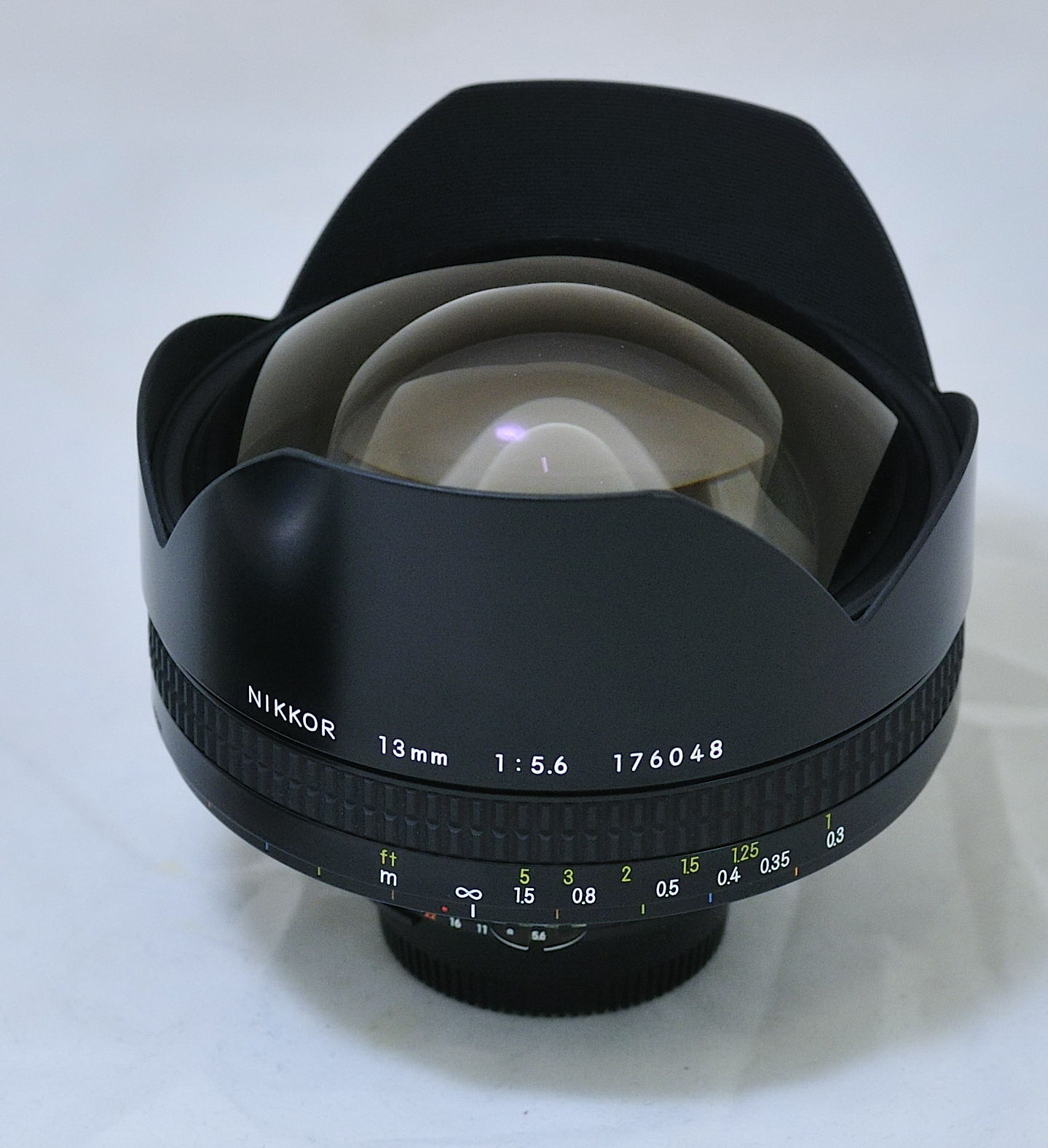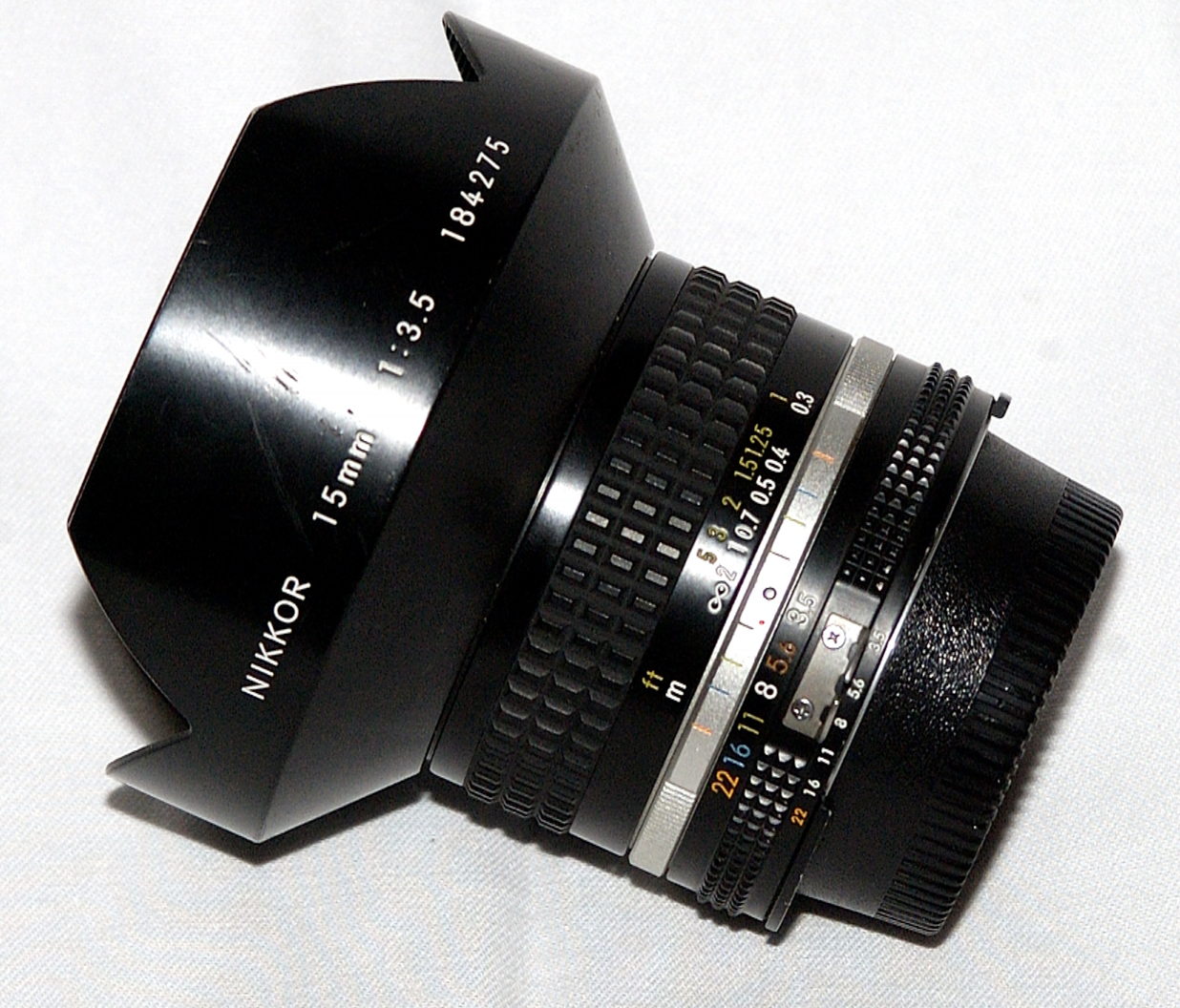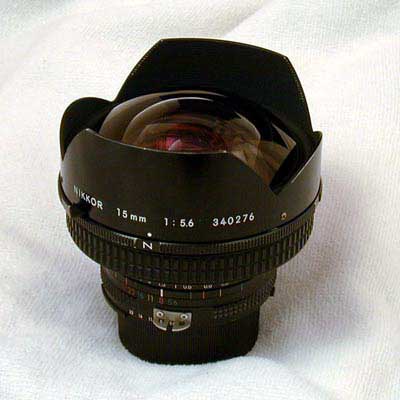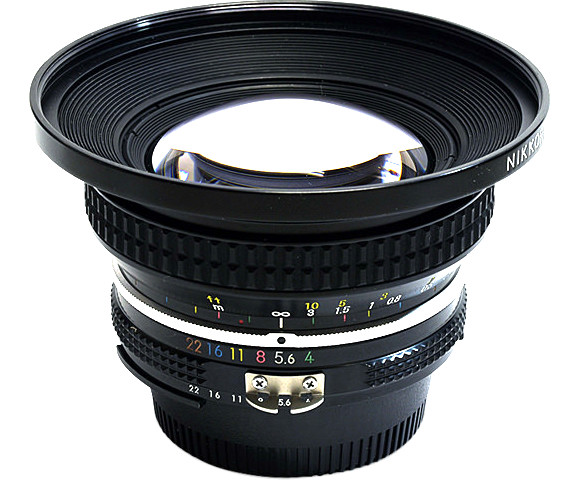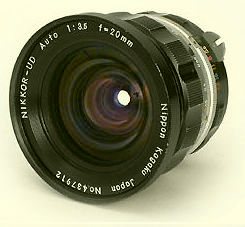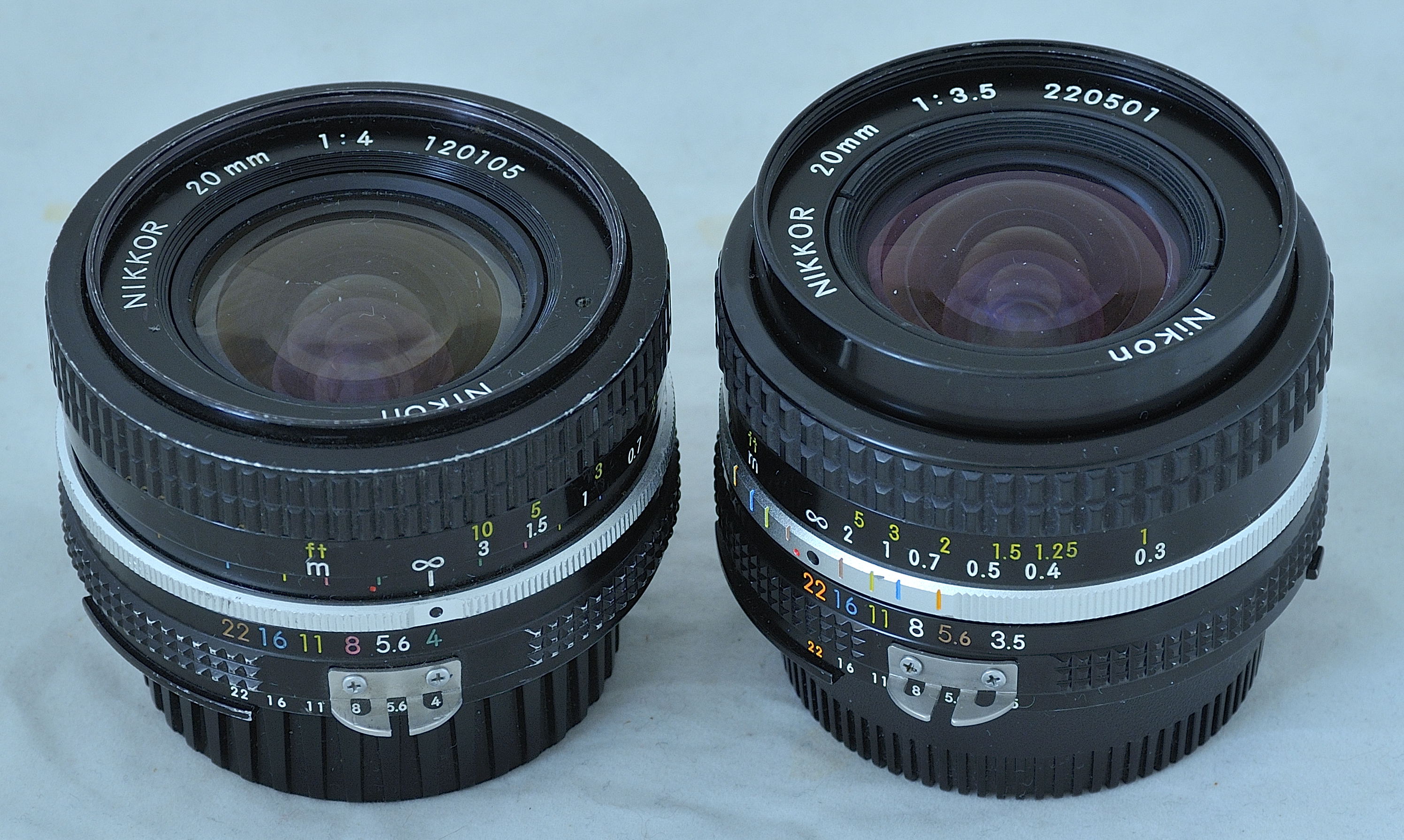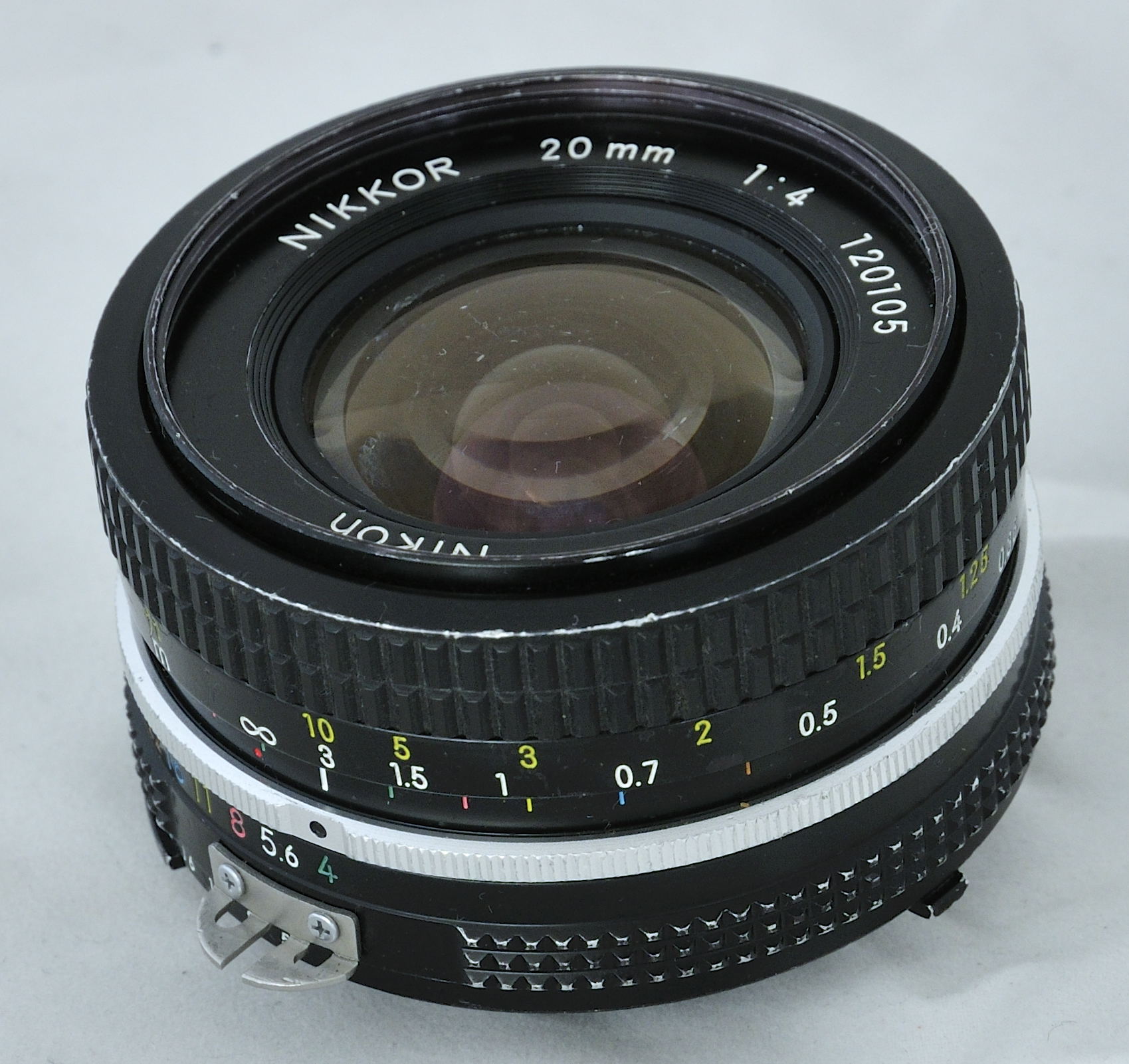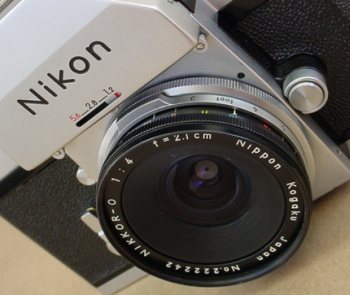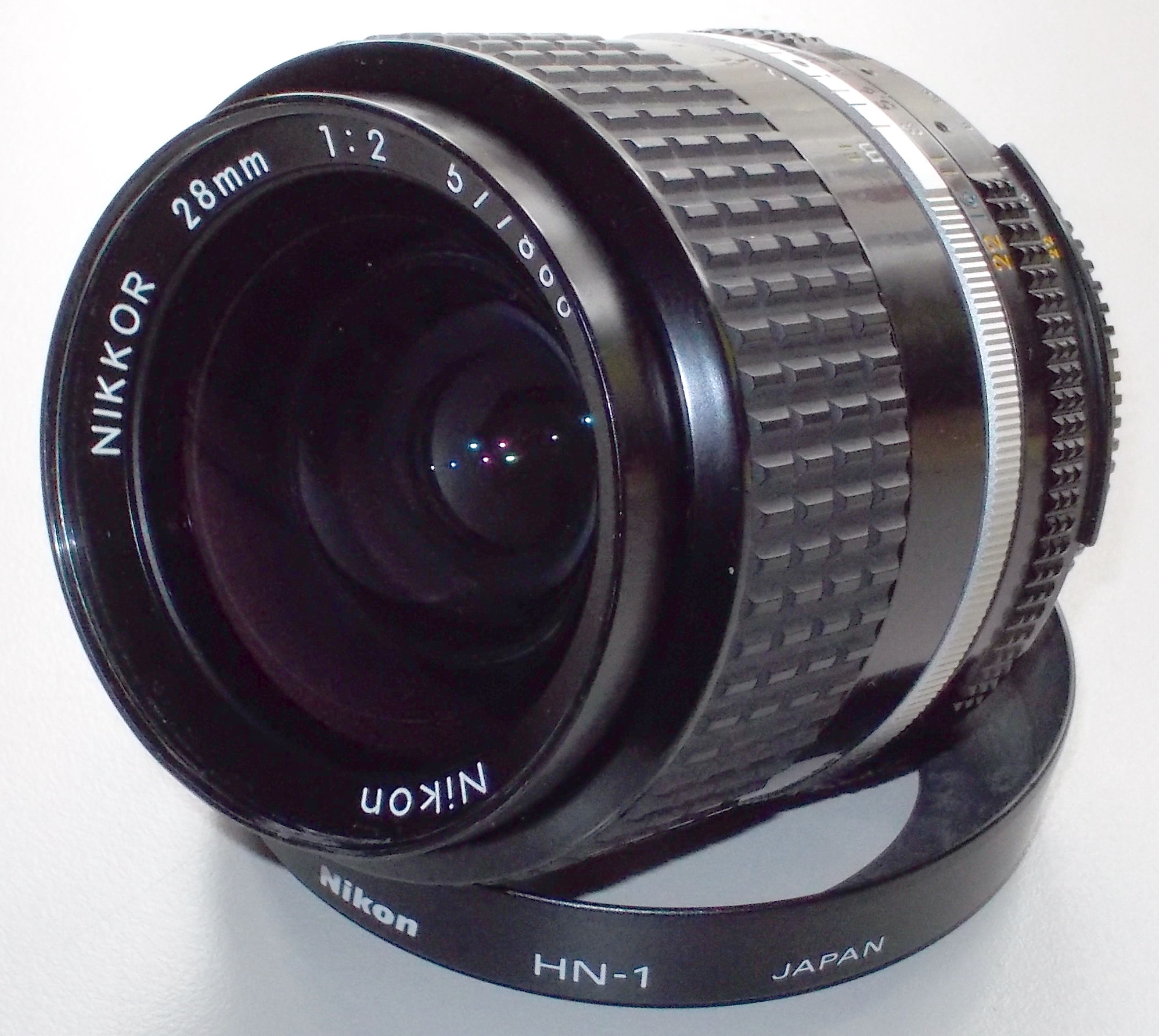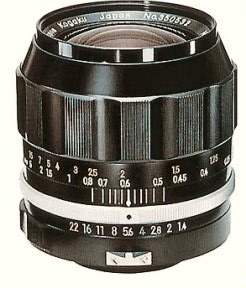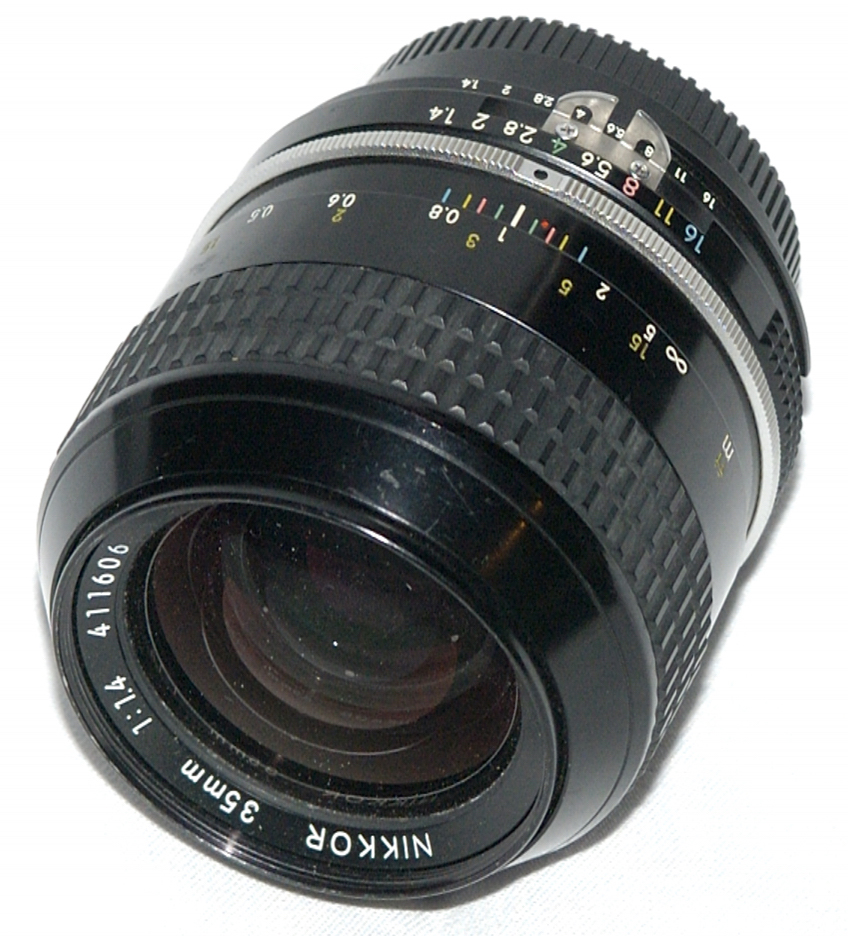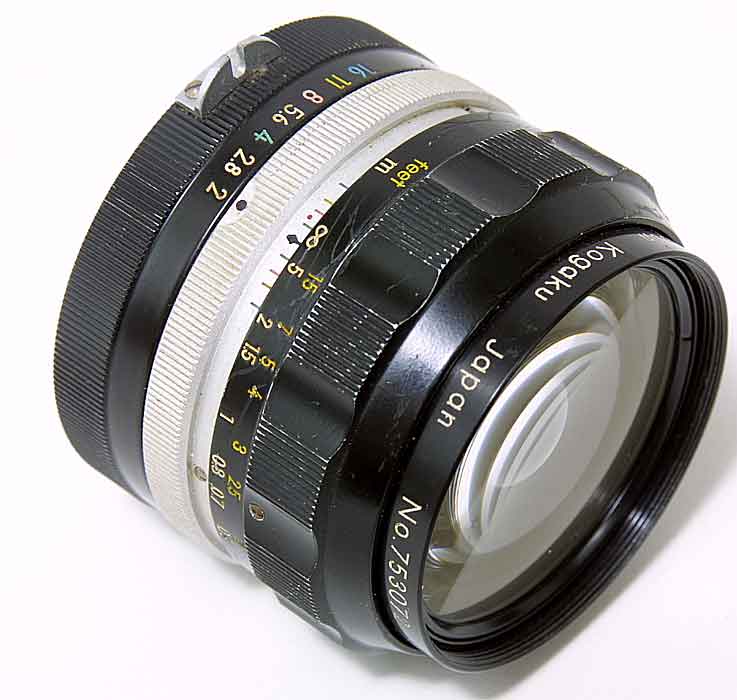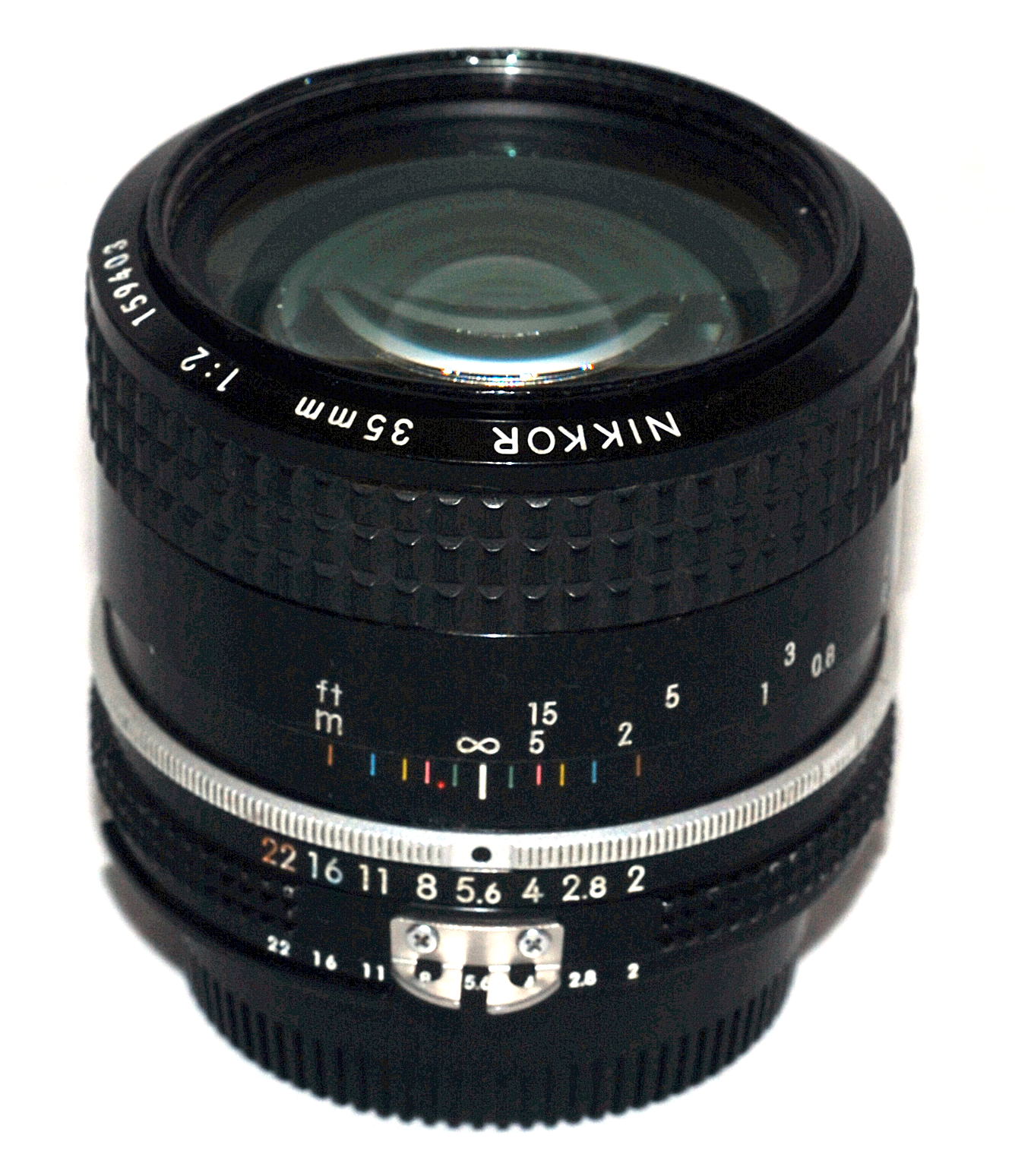Nikkor wide-angle lensesNikon Corporation produced a large variety of wide-angle lenses. Hereafter all wide-angle-lenses will be listed, without - however - lenses for special purposes, like PC (Perspective Control) lenses. Series-E lenses as well as the fish-eye lenses, and the lenses made for special purpose can be found in the respective chapters. Main technical specifications of the wide angle lenses can be found in this matrix.
5.6/13 mm.
This is - what many publicists and photographers say - an incredible lens. It has a wide angle of 118°, has 16 elements in 12 groups, weights in at 1.25 kilo, focuses down to 30 cm., thanks to the CRC-system (CRC = close range correction) - aka as floating element - and the aperture can be closed up to f/22, which gives it a depth of field from nearly 0.5 meter to infinity. It is a bit difficult to handle if fitted to a camera. The enormous lens barrel doesn´t give much space for big hands to move the aperture ring. If the lens is level all lines in a picture will be straight. On the rear end of the lens there is a filter ring taking 39 mm. filters; any filter is part of the optical system, so at least one UV-filter should stay on it. The first version (Nikkor-HD.C 5.6/13 mm.) - introduced in June 1975 - has no AI-mount; we had to wait for June 1977 to get the AI-version, an AIS-version was introduced in March 1982.
3.5/15 mm.
This successor of the lens mentioned hereafter is a very nice and sharp wide-angle lens with a view of 110°. The AI-version was introduced in August 1979, the AIS-version in February 1982. Both versions have the CRC-system and four turret-mounted filters.
5.6/15 mm.
This wide-angel lens was shown at the Photokina 1970 as the than widest lens other than the fish-eye lens. It has a wide view of 110°, a filter turret with 4 filters and, if at level, all lines in the image will remain straight. It is a bit difficult to handle because of the very small focusing ring. Its enormous depth-of-field practically eliminates the need to focus at smaller f/stops, moderate or greater distances. In May 1977 an AI-version became available.
3.5/18 mm. This very compact wide-angle lens was introduced in February 1982 as an AIS-lens. Other versions don´t exist. It has CRC (close range correction) which give this 100° lens crisp images, even in the corner. It takes 72 mm filters and has a special hood (HK-9) which can be clamped on the front ring.
4/18 mm.
This compact and light-weight predecessor of the 3.5/18mm lens - introduced in February 1975 - has no AI-coupling. It also lacks the CRC-system, which makes the corners at close distances a bit soft. In June 1977 the AI-version was presented; an AIS-version never appeared on the market. Both versions can take 86 mm. filters or Series 9 filters which are retained in the screw-on lens hood.
2.8/20 mm. This magnificent wide-angle lens is been considered as one of the best wides Nikon ever built. As an AIS-version this strong all-metal lens was introduced in December 1984. It takes 62 mm filters and a screw-in hood (HK-14). In July 1989 the first AF-version was put on the market. It has the same optical construction as its manual brother but doesn´t give the same solid feeling. In March 1994 the AF-D-version was introduced. The two AF-versions have a bayonet hood (HB-4). All versions feature the famous Nikon Integrated Coating. Even wide open all images at nearly all distances are razor sharp.
3.5/20 mm.
Nikkor-UD 3.5/20 mm. This Nikkor-UD with Nippon Kogaku Japan engravings on the 72 mm. filter ring was one of the widest Nikkors when introduced in January 1968. It had an all-metal scalloped lens barrel and can be mounted on older Nikon SLR´s only.
Nikkor AI 4/20mm and Nikkor AI/S 3.5/20mm. In March 1979 the successor of the 4/20 mm. lens was introduced. It has a totally different optical construction as the Nikkor-UD. It has an AI-coupling; In December 1981 an AIS-version was introduced. These versions are outstanding wide-angle lenses, which may be used in reverse position on a bellows or BR-2 macro ring. Magnifications up to 12X are possible. The two modern versions accept 52 mm. filters.
4/20 mm.
This very nice wide-angle lens is the successor of the Nikkor-UD lens. It was introduced in November 1974, having a non-AI coupling mechanism. It will fit older Nikon SLR´s only; it may be converted to fit AI-cameras. In March 1977 the AI-version was introduced. These two versions can be used in reverse on BR-2 for macro-photography as well. Both versions take 52mm filters and the HN-14 hood.
4/21 mm.
This very collectible wide-angle lens was made for the Nikon rangefinder cameras and for the Nikon F single lens reflex camera, which was introduced together with this lens in October 1959. To mount this lens on a SLR camera the mirror has to be locked up as the rear lens group protrudes into the camera body up to just in front of the film plane. On the accessory shoe a separate view finder has to be attached which gives an almost identical viewing angle of 81°. Lenses with serial numbers lower than 225001 can not be fitted on Nikkormat/Nikomat cameras. This remarkable lens has no exposure meter coupling so stop-down metering is required. Nowadays a sought after lens by Nikon F collectors.
2/24 mm.
This fast wide-angle lens with a viewing angle of 84° was introduced as an AI-version (see above) in October 1977. In those days one of the fastest wide lenses. The AIS-version appeared in December 1981. The CRC-system (in both lenses) allows the photographer to use this lens wide open, also at short distances. Probably because of its high price this excellent lens wasn´t a big seller. Nowadays hard to find. Both versions take 52 mm. filters and the HN-2 hood.
2.8/24 mm.
an early Nikkor-N 2.8/24 mm.
AIS-version of the Nikkor 2.8/24 mm. This very popular and a bit cheaper wide-angle lens entered the world as Nikkor-N in June 1971. It has so called floating elements, forerunner of the CRC-system. The Nikkor-N.C (C = coating) was introduced in December 1972. In May 1975 Nikon presented a redesigned lens barrel with rubber grip - in stead of the older scalloped lens barrel. Although the optical design wasn´t changed aperture can be set at 22. The AI-version that was presented in March 1977 has a new design and a new optical construction (9 individual lenses), followed by an AIS-version in October 1981. This 24mm.-lens has got an AF-version since September 1986. The still available AF-D version arrived in December 1993. All lenses take 52 mm filters and the HN-1 hood.
2/28 mm.
AIS-version resting on its HN-1 hood Introduced in April 1971 as Nikkor-N.C with a scalloped barrel and fitted with 9 lenses in 8 groups this fast wide-angle lens became an instant success. Some of the elements were floating elements for better sharpness at short distances. Together with the Nikkor-S 1.2/55 mm. this lens received - as one of the first Nikkors - the famous Nikon multi-layer coating. In February 1976 a new design of the lens barrel (with rubber grip) was introduced, followed by the AI-version in March 1977. The AIS-version, which was presented in December 1981 has a new optical design (8 individual lenses). All versions accept 52 mm filters and the HN-1 hood. Unfortunately Nikon did not made an autofocus version.
2.8/28 mm. AI/S-version with HN-2 hood This very popular lens is the successor of 3.5/28 mm. There is no version with a scalloped lens barrel. It came on the market in November 1974 in the rather modern straight barrel with rubber grip. In March 1977 a totally new optical design (7 individual lenses) was introduced as the AI-version. In September 1981 the AIS-version was - again - redesigned (8 individual lenses) and improved thanks to the CRC-system. This AIS-version is one of the best wide-angle lenses Nikon has ever built. In many comparison tests this lens scores in the top. The AF-version - introduced in July 1986 - is a copy of the Series-E (5 individual lenses). Nikon took this lens because its weight (205 gram) makes it easier for the AF-drive shaft. The AF-D version appeared in October 1994. It´s again a redesign (6 individual lenses). All versions take 52 mm. filters and the HN-2 hood. If you have to choose buy/take the AIS-version: excellent optical design and all-metal body.
3.5/28 mm. Nikkor-H.C version converted to AI-mount and AI-version This relatively cheap and light wide-angle lens was introduced as Nikkor-H in March 1960. Its optical design didn´t change much during its entire life. Although it was never regarded as the ´best in town´ the 6 individual elements give satisfying results. A coated version was introduced as Nikkor-H.C in February 1974. In March 1975 a redesigned lens barrel with rubber grip was put on the market. An AI-version - featuring the Nikon Integrated Coating - was introduced in March 1977, followed by the AIS-version in October 1981. All lenses take 52 mm. filters and the HN-2 hood. The AIS-version is a very nice performer and nowadays rather easy to find at low prices on the second hand market.
1.4/35 mm.
Introduced in March 1971 this relatively fast lens with a picture angle of 62° was one of the very first Nikkor lenses that received the famous multi-layer coating. It is an excellent reporter´s lens, even - the later models - on a digital reflex camera, giving a fast 52mm. equivalent focal length. In March 1971 the Nikkor-N.C - with improved coating - was introduced. A redesigned lens barrel with rubber grip appeared in May 1976. The AI-version - with a reduced aperture setting to f/16 - was presented in June 1977, followed by the AIS-version in February 1982.
2/35 mm.
Nikkor-O 2/35 mm. This lens entered the world as Nikkor-O in August 1962. In those days a rather fast reporter´s lens. Ideally for snap shots.
Nikkor 2/35mm. AI-version In October 1975 it has got the new barrel design. As nearly all Nikkors this lens became an AI-version in March 1977. AI/S-version The AIS-version - introduced in September 1981 - received a redesign of its optical construction (8 elements in 6 groups). The AF-version which appeared in April 1989 was in all aspects a redesign. To avoid a heavy AF-drive the optical construction was reduced to 6 elements in 5 groups. Finally an AF-D-version was introduced in March 1995. This last version - although not as strong as the metal AIS-lens - is a good standard lens on any digital reflex camera. All versions take the HN-3 hood.
2.8/35 mm.
The last lens in this listing of Nikkor wide-angle lenses is a real sleeper. It was never used by many photographers, although it is a lovely lens with more than acceptable performance. The first version (7 elements in 6 groups) - see above - was introduced in August 1959 as one of the companions of the new Nikon F. In December 1965 it was changed a bit cosmetically as well as in September 1973 at the introduction of the Nikkor-O.C. It received the new lens barrel design in January 1975. In March 1977 - at the introduction of the AI-version - the optical design was changed (6 individual elements). Again in September 1981 the optical design was changed (5 individual elements) alike the Series-E 2.5/35 mm. lens. The difference between f/2.5 and f/2.8 is very marginal. Both lenses might be fully identical. All versions take 52 mm. filters and the HN-3 hood.
|
